Paper Menu >>
Journal Menu >>
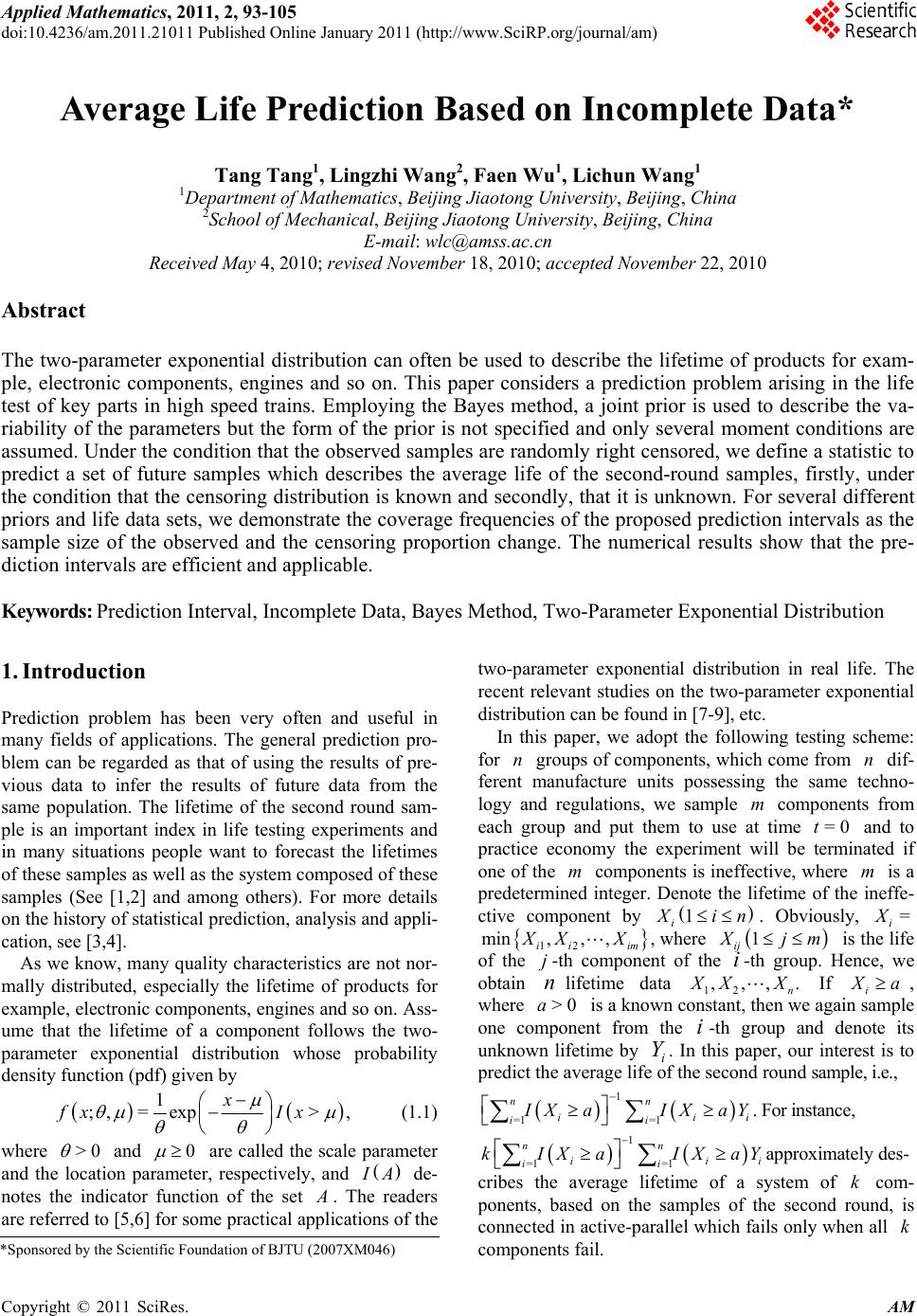 Applied Mathematics, 2011, 2, 93-105 doi:10.4236/am.2011.21011 Published Online January 2011 (http://www.SciRP.org/journal/am) Copyright © 2011 SciRes. AM Average Life Prediction Based on Incomplete Data* Tang Tang1, Lingzhi Wang2, Faen Wu1, Lichun Wang1 1Department of Mat hem at ic s, Beijing Jiaotong University, Beijing, China 2School of Mechanical, Beijing Jiaotong University, Beijing, China E-mail: wlc@amss.ac.cn Received May 4, 2010; revised November 18, 2010; accepted November 22, 2010 Abstract The two-parameter exponential distribution can often be used to describe the lifetime of products for exam- ple, electronic components, engines and so on. This paper considers a prediction problem arising in the life test of key parts in high speed trains. Employing the Bayes method, a joint prior is used to describe the va- riability of the parameters but the form of the prior is not specified and only several moment conditions are assumed. Under the condition that the observed samples are randomly right censored, we define a statistic to predict a set of future samples which describes the average life of the second-round samples, firstly, under the condition that the censoring distribution is known and secondly, that it is unknown. For several different priors and life data sets, we demonstrate the coverage frequencies of the proposed prediction intervals as the sample size of the observed and the censoring proportion change. The numerical results show that the pre- diction intervals are efficient and applicable. Keywords: Prediction Interval, Incomplete Data, Bayes Method, Two-Parameter Exponential Distribution 1. Introduction Prediction problem has been very often and useful in many fields of applications. The general prediction pro- blem can be regarded as that of using the results of pre- vious data to infer the results of future data from the same population. The lifetime of the second round sam- ple is an important index in life testing experiments and in many situations people want to forecast the lifetimes of these samples as well as the system composed of these samples (See [1,2] and among others). For more details on the history of statistical prediction, analysis and appli- cation, see [3,4]. As we know, many quality characteristics are not nor- mally distributed, especially the lifetime of products for example, electronic components, engines and so on. Ass- ume that the lifetime of a component follows the two- parameter exponential distribution whose probability density funct i o n (p df) given by 1 ;,= exp>, x fx Ix (1.1) where >0 and 0 are called the scale parameter and the location parameter, respectively, and I A de- notes the indicator function of the set A . The readers are referred to [5,6] for some practical applications of the two-parameter exponential distribution in real life. The recent relevant studies on the two-parameter exponential distribution can be found in [7-9], etc. In this paper, we adopt the following testing scheme: for n groups of components, which come from n dif- ferent manufacture units possessing the same techno- logy and regulations, we sample m components from each group and put them to use at time =0t and to practice economy the experiment will be terminated if one of the m components is ineffective, where m is a predetermined integer. Denote the lifetime of the ineffe- ctive component by 1 i X in . Obviously, = i X 12 min,, ,, ii im XX Xwhere 1 ij X jm is the life of the j-th component of the i-th group. Hence, we obtain nlifetime data 12 ,,,. n X XX If i X a, where >0a is a known constant, then we again sample one component from the i-th group and denote its unknown lifetime by i Y. In this paper, our interest is to predict the av erage life of the second round sample, i .e., 1 =1 =1 nn iii ii I Xa IXaY . For i nstance, 1 =1 =1 nn iii ii kIXa IXaY approximately des- cribes the average lifetime of a system of k com- ponents, based on the samples of the second round, is connected in active-parallel which fails on ly when all k components fail. *Sponsored by the Scientific Foundation of BJTU (2007XM046) 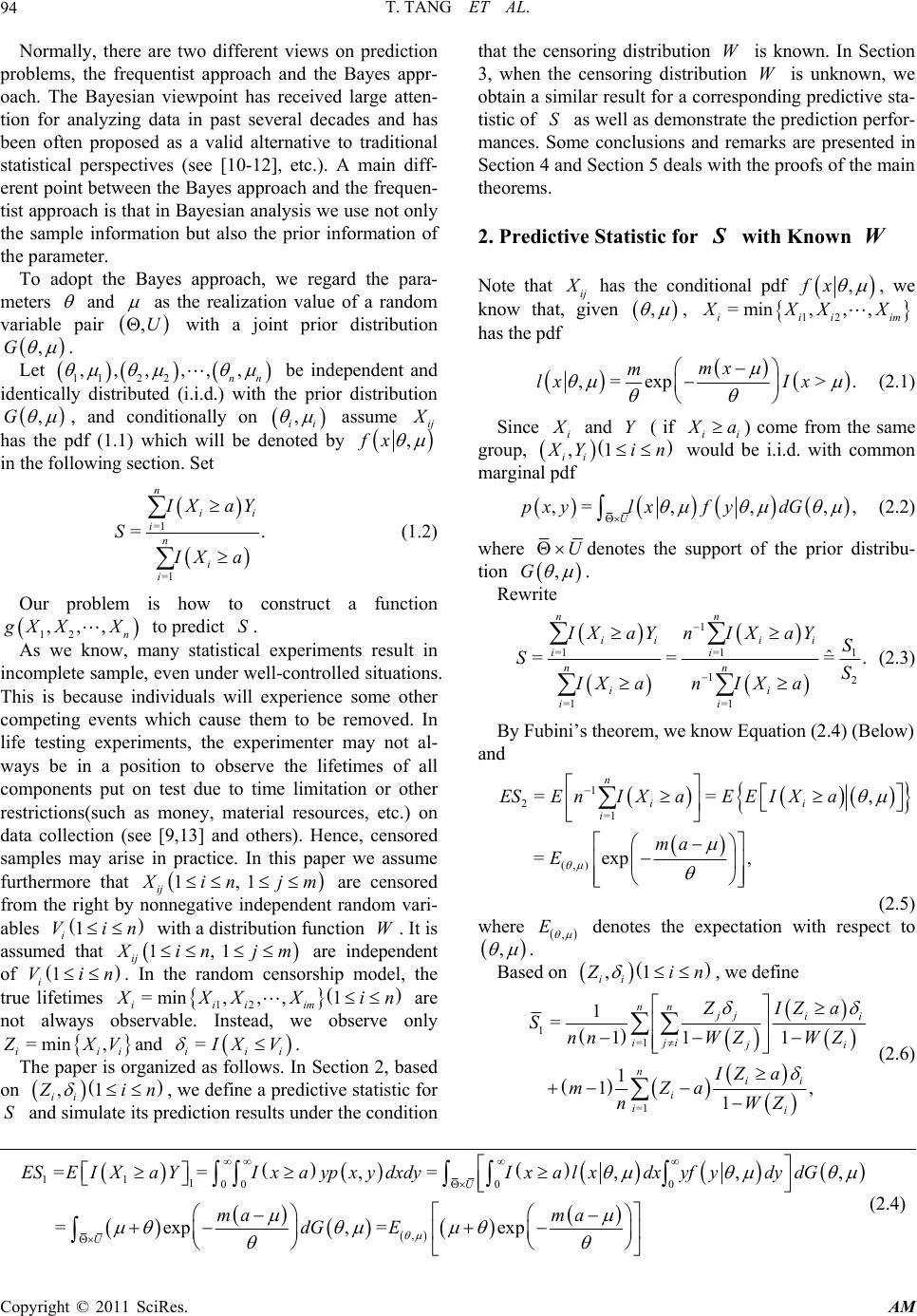 T. TANG ET AL. Copyright © 2011 SciRes. AM 94 Normally, there are two different views on prediction problems, the frequentist approach and the Bayes appr- oach. The Bayesian viewpoint has received large atten- tion for analyzing data in past several decades and has been often proposed as a valid alternative to traditional statistical perspectives (see [10-12], etc.). A main diff- erent point between the Bayes approach an d the frequen- tist approach is that in Bayesian analysis we use not on ly the sample information but also the prior information of the parameter. To adopt the Bayes approach, we regard the para- meters and as the realization value of a random variable pair ,U with a joint prior distribution ,G . Let 112 2 ,,,,,, nn be independent and identically distributed (i.i.d.) with the prior distribution ,G , and conditionally on , ii assume ij X has the pdf (1.1) which will be denoted by ,fx in the following section. Set =1 =1 =. n ii in i i I XaY S I Xa (1.2) Our problem is how to construct a function 12 ,,, n g XX X to predict S. As we know, many statistical experiments result in incomplete sample, even under well-controlled situations. This is because individuals will experience some other competing events which cause them to be removed. In life testing experiments, the experimenter may not al- ways be in a position to observe the lifetimes of all components put on test due to time limitation or other restrictions(such as money, material resources, etc.) on data collection (see [9,13] and others). Hence, censored samples may arise in practice. In this paper we assume furthermore that 1, 1 ij X in jm are censored from the right by nonnegative independent random vari- ables 1 i Vin with a distribution function W. It is assumed that 1, 1 ij X in jm are independent of 1 i Vin . In the random censorship model, the true lifetimes 12 =min,, ,1 iiiim X XX Xin are not always observable. Instead, we observe only =min , iii Z XVand = iii I XV . The paper is organized as follows. In Section 2, based on ,1 ii Z in , we define a predictive statistic for S and simulate its prediction results under the condition that the censoring distribution W is known. In Section 3, when the censoring distribution W is unknown, we obtain a s imilar result for a co rresponding predictive sta- tistic of S as well as demonstrate the prediction perfor- mances. Some conclusions and remarks are presented in Section 4 and Section 5 deals with the proofs of the main theorems. 2. Predictive Statistic for S with Known W Note that ij X has the conditional pdf ,fx , we know that, given , , 12 =min,, , iiiim XXXX has the pdf ,=exp >. mx m lx Ix (2.1) Since i X and Y ( if ii X a) come from the same group, ,1 ii X Yin would be i.i.d. with common marginal pdf ,=,, ,, U pxylxf ydG (2.2) where U denotes the support of the prior distribu- tion ,G . Rewrite 1 =1=1 1 12 =1 =1 ˆ == =. nn ii ii ii nn ii ii IX aY nIX aYS SS IX anIXa (2.3) By Fubini’s theorem, we know Equation (2.4) (Below) and 1 2=1 (,) ==, =exp, n ii i ESEnIXaEEI Xa ma E (2.5) where , E denotes the expectation with respect to , . Based on ,1 ii Z in , we define 1=1 =1 1 =11 1 1 1, 1 nn jj ii iji ji nii i ii ZIZ a SnnWZWZ IZ a mZa nWZ (2.6) 11 1000 0 , == ,=,,, =exp,=exp U U ESE I XaYI xaypxydxdyI xalxdxyfydydG ma ma dG E (2.4)  T. TANG ET AL. Copyright © 2011 SciRes. AM 95 and 2=1 1 =. 1 nii ii IZ a SnWZ (2.7) Note that conditionally on , ii all 1 i Z in are i.i.d. with the distribution function =1 11,HWzLz , where 0 (,)=,, z Lzl xdx we have Equation (2.8) (B elow) and 11 21 , 2 , =1 =, 1 =exp=. xv IZa ES EWZ Ix a EdWvlxdx Wx ma EES (2.9) Hence, the statistics =1,2 i Si have the same exp- ectation as =1,2 i Si . Set 1 2 =. S SS (2.10) Remark 1. Note that it is almost impossible that all i ’s are equal to zero, so 1 S and 2 S are reasonable estimators for 1 S and 2 S, respectively. The main result in this section can be formulated in the following theorem. Theorem 1. If the following conditions are satisfied: 1) 22 <, <;EE 2) ,,<;E 3) 2 2<; 1 XIXa EWX then 0, p SS n where 2 ,= , 1 X EWX , ,= , 1 IX a EWX and p denotes con- vergence in probability. Clearly, S can be used as a predictive statistic for S in this case. Especially, when there is no censors hip =, =1 iii ZX , 1 S and 2 S turn into, respectively 10 =1 =1 1 =1 1 1 nn ji iji n ii i SXIXa nn mXaIXa n (2.11) and 20 =1 1 =. n i i SIXa n (2.12) Consequently, we use 01020 =SSS as a prediction statistics of S. Normally, we choose Gamma prior for the parameters , , however, it is easy to see that Theorem 1 does not depend on any specific prior distribution. This shows that for any a prior distribution satisfying the conditions of Theorem 1, the conclusion of Theorem 1 will hold. So in the simulation study, we let the prior distribution of parameters 500,1300 ,Uniform (2.13) 800,1400 ,Uniform (2.14) and the censoring distribution be 1=1 111 1 1 =,, 11 1 1, 1 =,, 11 1 nn jj ii iji ji xv xv xv ZIZ a ESE EE nnWZ WZ ZaIZa mEE WZ xIxa EdWv lxdxdWv lxdx Wx Wx mE 1 , , 1 1 =expexp=, xaIxa dWv lxdx Wx ma ma m EES mm (2.8) 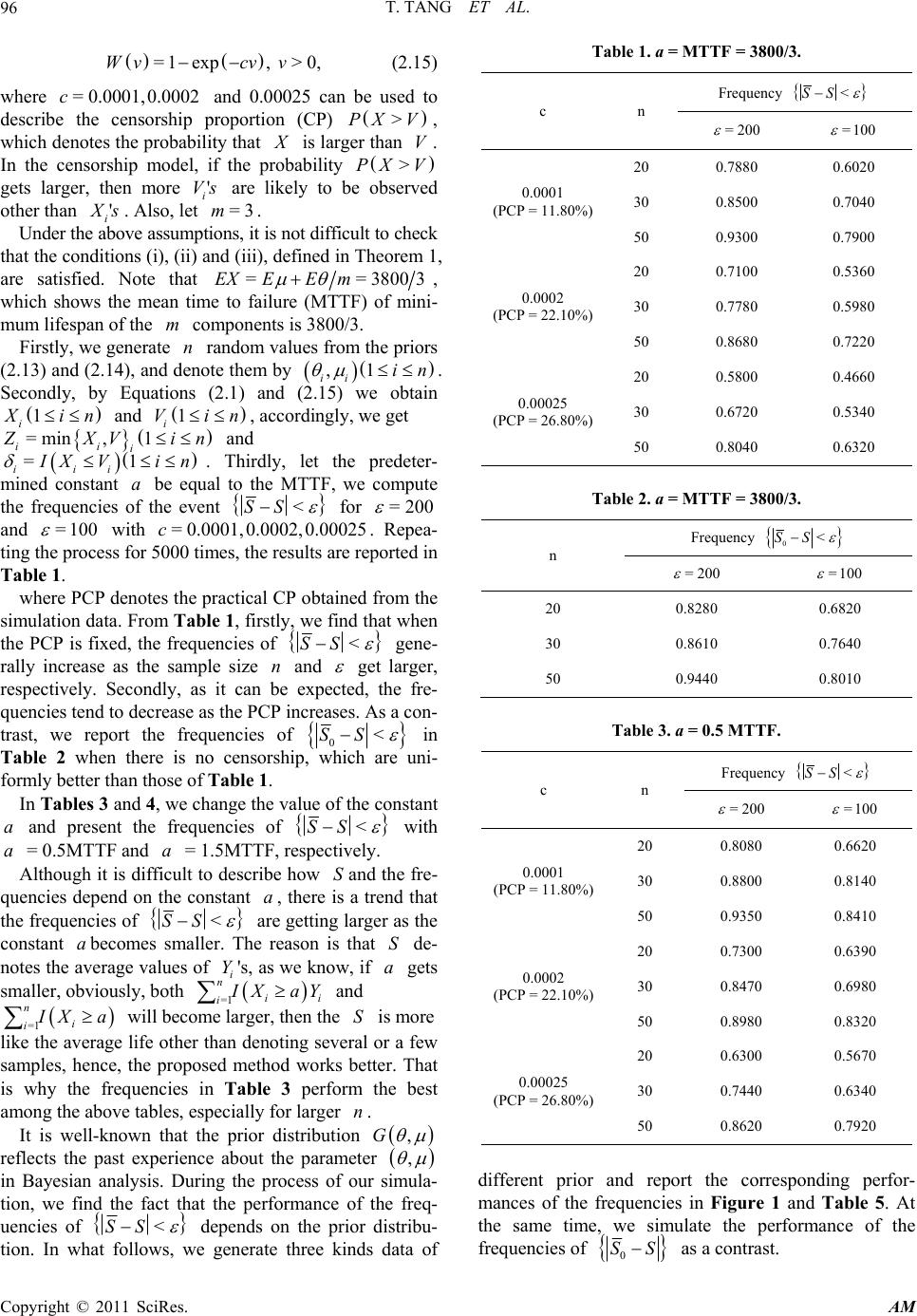 T. TANG ET AL. Copyright © 2011 SciRes. AM 96 =1exp, >0,Wvcv v (2.15) where = 0.0001,0.0002c and 0.00025 can be used to describe the censorship proportion (CP) >PXV, which denotes the probability that X is larger than V. In the censorship model, if the probability >PX V gets larger, then more ' i Vs are likely to be observed other than ' i X s. Also, let =3m. Under the above assumptions, it is not difficult to check that the conditions (i), (ii) and (iii), defined in Theorem 1, are satisfied. Note that ==38003EXEE m , which shows the mean time to failure (MTTF) of mini- mum lifespan of the m components is 3800/3. Firstly, we generate n random values from the priors (2.13) and (2.14), and denote them by ,1 ii in . Secondly, by Equations (2.1) and (2.15) we obtain 1 i X in and 1 i Vin , accordingly, we get =min,1 ii i Z XVin and =1 iii I XV in . Thirdly, let the predeter- mined constant a be equal to the MTTF, we compute the frequencies of the event <SS for =200 and =100 with = 0.0001,0.0002,0.00025c. Repea- ting the process for 5000 times, the results are reported in Table 1. where PCP denotes the practical CP obtained from the simulation data. From Table 1, firstly, we find that when the PCP is fixed, the frequencies of <SS gene- rally increase as the sample size n and get larger, respectively. Secondly, as it can be expected, the fre- quencies tend to decrease as the PCP increases. As a con- trast, we report the frequencies of 0<SS in Table 2 when there is no censorship, which are uni- formly better than those of Table 1. In Tab les 3 and 4, we change the value of the constant a and present the frequencies of <SS with a = 0.5MTTF and a = 1.5M T T F, res pectively. Although it is difficult to describe how Sand the fr e- quencies depend on the constant a, there is a trend that the frequencies of <SS are getting larger as the constant abecomes smaller. The reason is that S de- notes the average values of i Y's, as we know, if a gets smaller, obviously, both =1 n ii i I XaY and =1 n i i I Xa will become larger, then the S is more like the average life other than denoting several or a few samples, hence, the proposed method works better. That is why the frequencies in Table 3 perform the best among the above tables, especially for larger n. It is well-known that the prior distribution ,G reflects the past experience about the parameter , in Bayesian analysis. During the process of our simula- tion, we find the fact that the performance of the freq- uencies of <SS depends on the prior distribu- tion. In what follows, we generate three kinds data of Table 1. a = MTTF = 3800/3. c n Frequency <SS = 200 =100 0.0001 (PCP = 11.80%) 20 0.7880 0.6020 30 0.8500 0.7040 50 0.9300 0.7900 0.0002 (PCP = 22.10%) 20 0.7100 0.5360 30 0.7780 0.5980 50 0.8680 0.7220 0.00025 (PCP = 26.80%) 20 0.5800 0.4660 30 0.6720 0.5340 50 0.8040 0.6320 Table 2. a = MTTF = 3800/3. n Frequency 0<SS =200 =100 20 0.8280 0.6820 30 0.8610 0.7640 50 0.9440 0.8010 Table 3. a = 0.5 MTTF. c n Frequency <SS =200 =100 0.0001 (PCP = 11.80%) 20 0.8080 0.6620 30 0.8800 0.8140 50 0.9350 0.8410 0.0002 (PCP = 22.10%) 20 0.7300 0.6390 30 0.8470 0.6980 50 0.8980 0.8320 0.00025 (PCP = 26.80%) 20 0.6300 0.5670 30 0.7440 0.6340 50 0.8620 0.7920 different prior and report the corresponding perfor- mances of the frequencies in Figure 1 and Table 5. At the same time, we simulate the performance of the frequencies of 0 SS as a contrast. 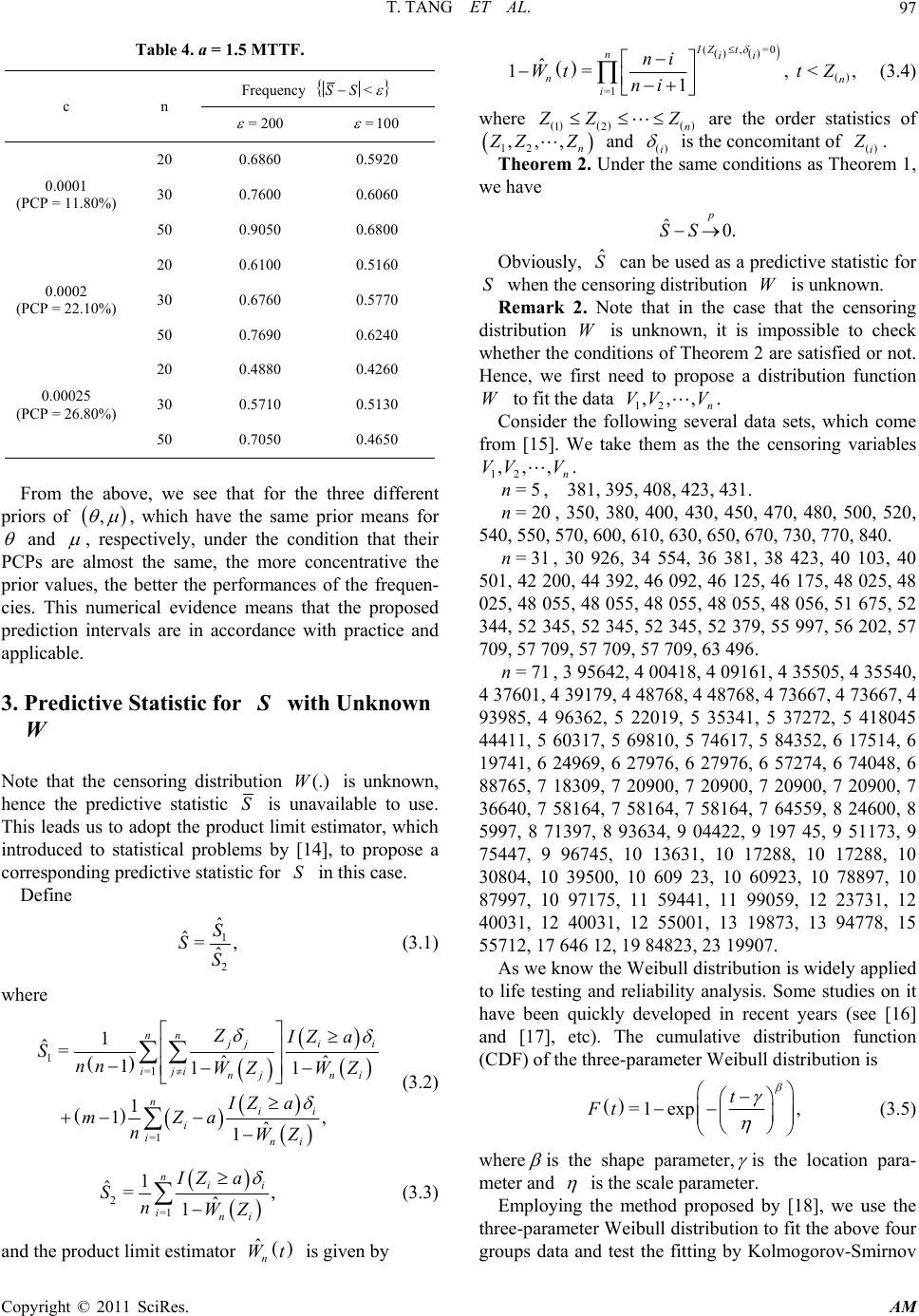 T. TANG ET AL. Copyright © 2011 SciRes. AM 97 Table 4. a = 1.5 MTTF. c n Frequency <SS =200 =100 0.0001 (PCP = 11.80 %) 20 0.6860 0.5920 30 0.7600 0.6060 50 0.9050 0.6800 0.0002 (PCP = 22.10 %) 20 0.6100 0.5160 30 0.6760 0.5770 50 0.7690 0.6240 0.00025 (PCP = 26.80 %) 20 0.4880 0.4260 30 0.5710 0.5130 50 0.7050 0.4650 From the above, we see that for the three different priors of , , which have the same prior means for and , respectively, under the condition that their PCPs are almost the same, the more concentrative the prior values, the better the performances of the frequen- cies. This numerical evidence means that the proposed prediction intervals are in accordance with practice and applicable. 3. Predictive Statistic for S with Unknown W Note that the censoring distribution (.)W is unknown, hence the predictive statistic S is unavailable to use. This leads us to adopt the product limit estimator, which introduced to statistical problems by [14], to propose a corresponding predictive statistic for S in this case. Define 1 2 ˆ ˆ=, ˆ S SS (3.1) where 1=1 =1 1 ˆ=ˆˆ 111 1 1, ˆ 1 nn jj ii iji nj ni nii i ini ZIZ a Snn WZ WZ IZ a mZa nWZ (3.2) 2=1 1 ˆ=, ˆ 1 nii ini IZ a SnWZ (3.3) and the product limit estimator ˆn Wt is given by (,=0 =1 ˆ 1=, <, 1 IZ t nii nn i ni Wtt Z ni (3.4) where 12 n Z ZZ are the order statistics of 12 ,,, n Z ZZ and i is the concomitant of i Z . Theorem 2. Under the same conditions as Theorem 1, we have ˆ0. p SS Obviously, ˆ S can be used as a predictive statistic for S when the censoring distribution W is unknown. Remark 2. Note that in the case that the censoring distribution W is unknown, it is impossible to check whether the conditions of Theorem 2 are satisfied or not. Hence, we first need to propose a distribution function W to fit the data 12 ,,, n VV V. Consider the following several data sets, which come from [15]. We take them as the the censoring variables 12 ,,, n VV V. =5n, 381, 395, 408, 423, 431. =20n, 350, 380, 400, 430, 450, 470, 480, 500, 520, 540, 550, 570, 600, 610, 630, 650, 670, 730, 770, 840. =31n, 30 926, 34 554, 36 381, 38 423, 40 103, 40 501, 42 200 , 44 392, 46 092, 46 125, 46 175, 48 02 5, 48 025, 48 055 , 48 055, 48 055, 48 055, 48 056, 51 67 5, 52 344, 52 345 , 52 345, 52 345, 52 379, 55 997, 56 20 2, 57 709, 57 709, 57 709, 57 709, 63 496. =71n, 3 95642, 4 004 18 , 4 09 161 , 4 355 05 , 4 35 54 0, 4 37601, 4 39179, 4 48768, 4 48768, 4 73667, 4 73667, 4 93985, 4 96362, 5 22019, 5 35341, 5 37272, 5 418045 44411, 5 60317, 5 69810, 5 74617, 5 84352, 6 17514, 6 19741, 6 24969, 6 27976, 6 27976, 6 57274, 6 74048, 6 88765, 7 18309, 7 20900, 7 20900, 7 20900, 7 20900, 7 36640, 7 58164, 7 58164, 7 58164, 7 64559, 8 24600, 8 5997, 8 71397, 8 93634, 9 04422, 9 197 45, 9 51173, 9 75447, 9 96745, 10 13631, 10 17288, 10 17288, 10 30804, 10 39500, 10 609 23, 10 60923, 10 78897, 10 87997, 10 97175, 11 59441, 11 99059, 12 23731, 12 40031, 12 40031, 12 55001, 13 19873, 13 94778, 15 55712, 17 646 12, 19 84823, 23 19907. As we know the Weibu ll distrib ution is widely ap plied to life testing and reliability analysis. Some studies on it have been quickly developed in recent years (see [16] and [17], etc). The cumulative distribution function (CDF) of the three-parameter Weibull distribution is =1 exp, t Ft (3.5) where is the shape parameter, is the location para- meter and is the scale parameter. Employing the method proposed by [18], we use the three-parameter Weibull distribution to fit the above four groups data and test the fitting by Kolmogorov-Smirnov 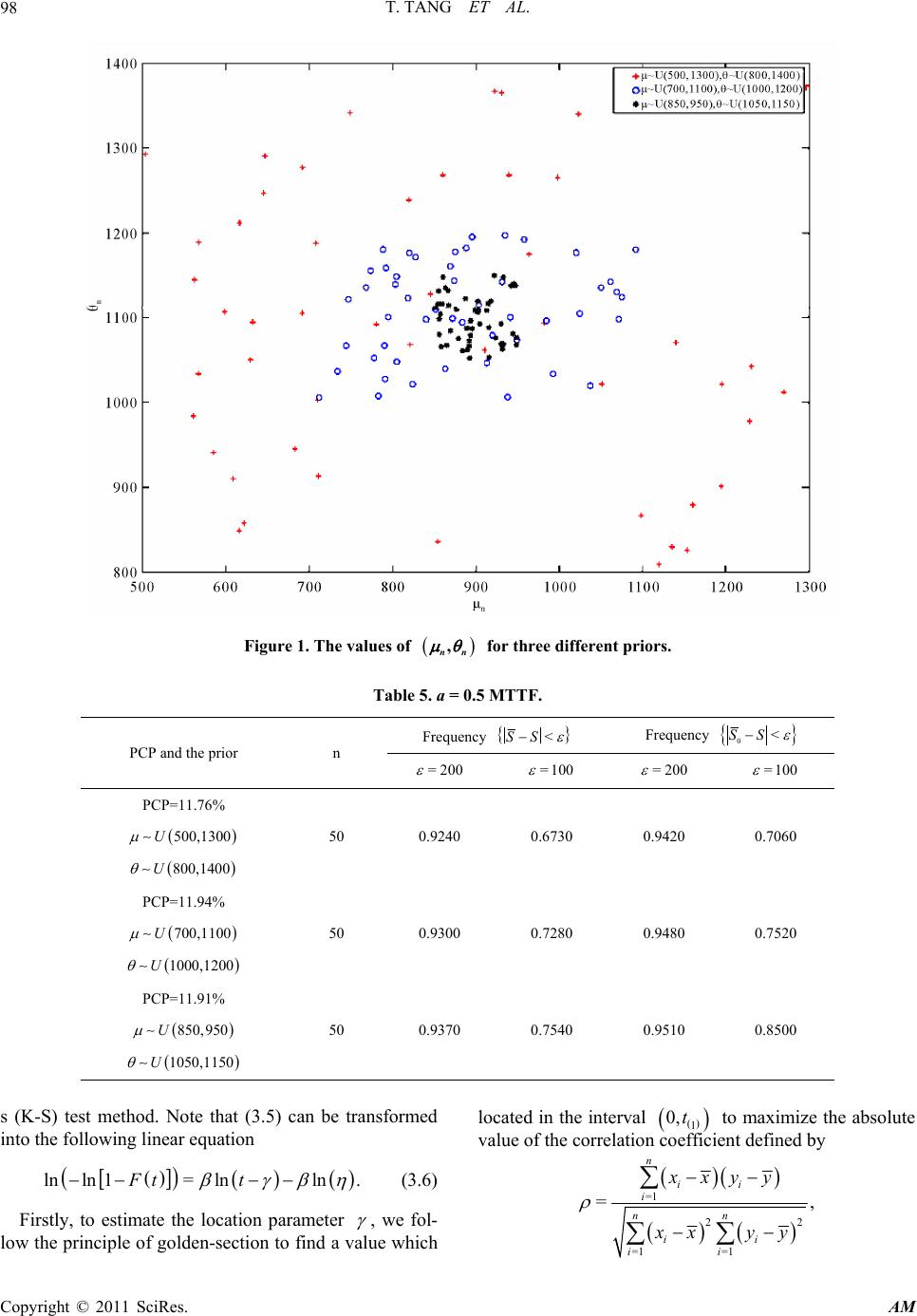 T. TANG ET AL. Copyright © 2011 SciRes. AM 98 Figure 1. The values of , nn for three different priors. Table 5. a = 0.5 MTTF. PCP and the prior n Frequency <SS Frequency 0<SS = 200 =100 =200 =100 PCP=11.76% 50 0.9240 0.6730 0.9420 0.7060 500,1300U 800,1400U PCP=11.94% 50 0.9300 0.7280 0.9480 0.7520 700,1100U 1000,1200U PCP=11.91% 50 0.9370 0.7540 0.9510 0.8500 850,950U 1050,1150U s (K-S) test method. Note that (3.5) can be transformed into the following linear equation lnln 1=lnln.Ft t (3.6) Firstly, to estimate the location parameter , we fol- low the principle of gold en-section to find a value which located in the interval 1 0,t to maximize the absolute value of the correlation coefficient defined by =1 22 =1 =1 =, n ii i nn ii ii xxyy xx yy 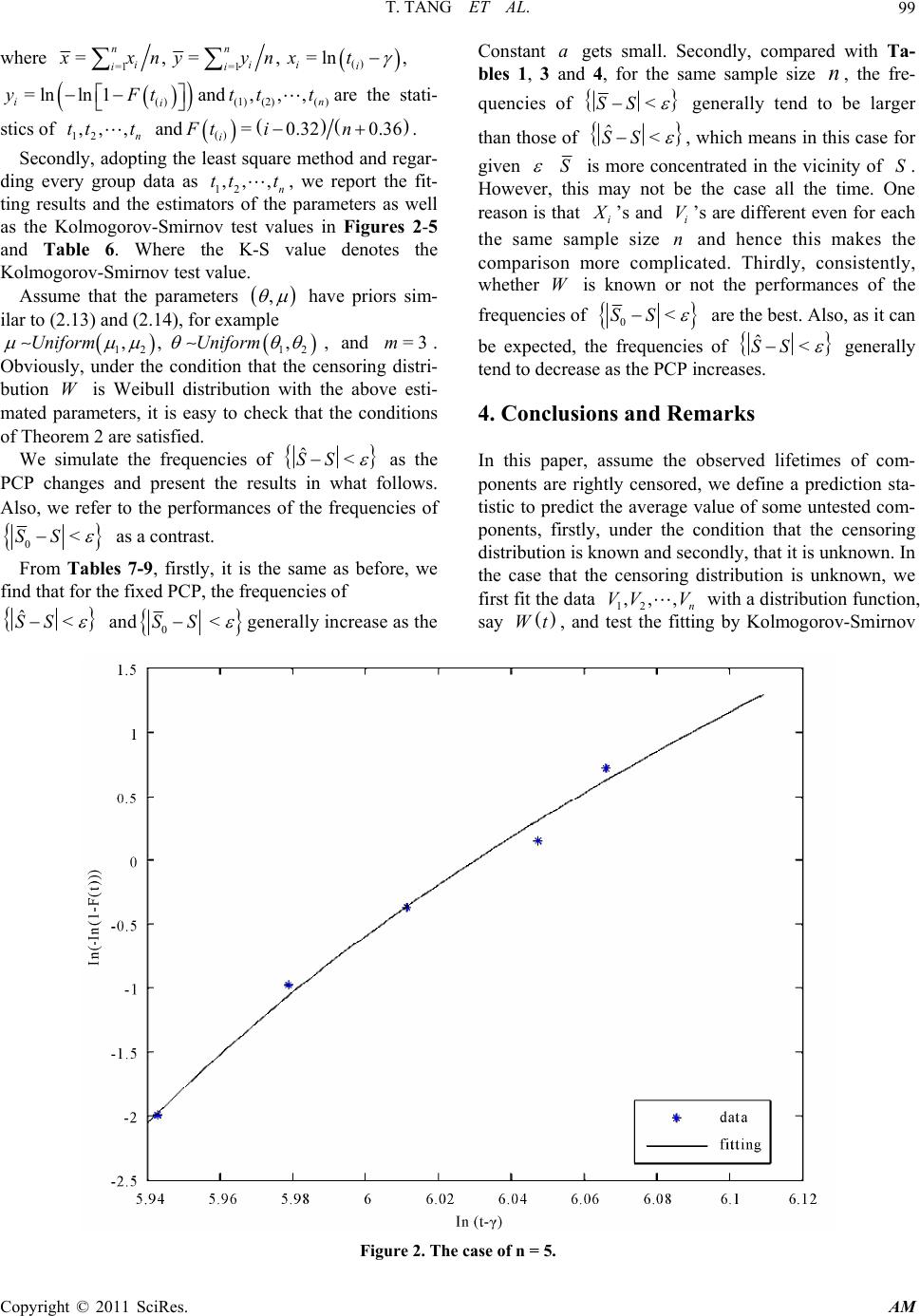 T. TANG ET AL. Copyright © 2011 SciRes. AM 99 where =1 =1 =, =, =ln, nn iii i ii xxnyynxt =lnln1 ii yFt and (1)(2)( ) ,,, n tt tare the stati- stics of 12 ,, , n tt t and =0.320.36 i Ft in. Secondly, adoptin g the least square method and regar- ding every group data as 12 ,, , n tt t, we report the fit- ting results and the estimators of the parameters as well as the Kolmogorov-Smirnov test values in Figures 2-5 and Table 6. Where the K-S value denotes the Kolmogorov-Smirnov test value. Assume that the parameters , have priors sim- ilar to (2.13 ) and (2.14), fo r example 12 12 ,, ,Uniform Uniform , and =3m. Obviously, under the condition that the censoring distri- bution W is Weibull distribution with the above esti- mated parameters, it is easy to check that the conditions of Theorem 2 are satisfied. We simulate the frequencies of ˆ< SS as the PCP changes and present the results in what follows. Also, we refer to the performances of the frequencies of 0<SS as a contrast. From Tables 7-9, firstly, it is the same as before, we find that for the fixed PCP, the frequencies of ˆ< SS and 0<SS generally increase as the Constant a gets small. Secondly, compared with Ta- bles 1, 3 and 4, for the same sample size n, the fre- quencies of <SS generally tend to be larger than those of ˆ< SS , which means in this case for given S is more concentrated in the vicinity of S. However, this may not be the case all the time. One reason is that i X ’s and i V’s are different even for each the same sample size n and hence this makes the comparison more complicated. Thirdly, consistently, whether W is known or not the performances of the frequencies of 0<SS are the best. Also, as it can be expected, the frequencies of ˆ< SS generally tend to decrease as the PCP increases. 4. Conclusions and Remarks In this paper, assume the observed lifetimes of com- ponents are rightly censored, we define a prediction sta- tistic to predict the average value of some untested com- ponents, firstly, under the condition that the censoring distribution is known and secondly, that it is unknown. In the case that the censoring distribution is unknown, we first fit the data 12 ,,, n VV V with a distribution function, say Wt, and test the fitting by Kolmogorov-Smirnov Figure 2. The case of n = 5.  T. TANG ET AL. Copyright © 2011 SciRes. AM 100 Figure 3. The case of n = 20. Figure 4. The case of n = 31. 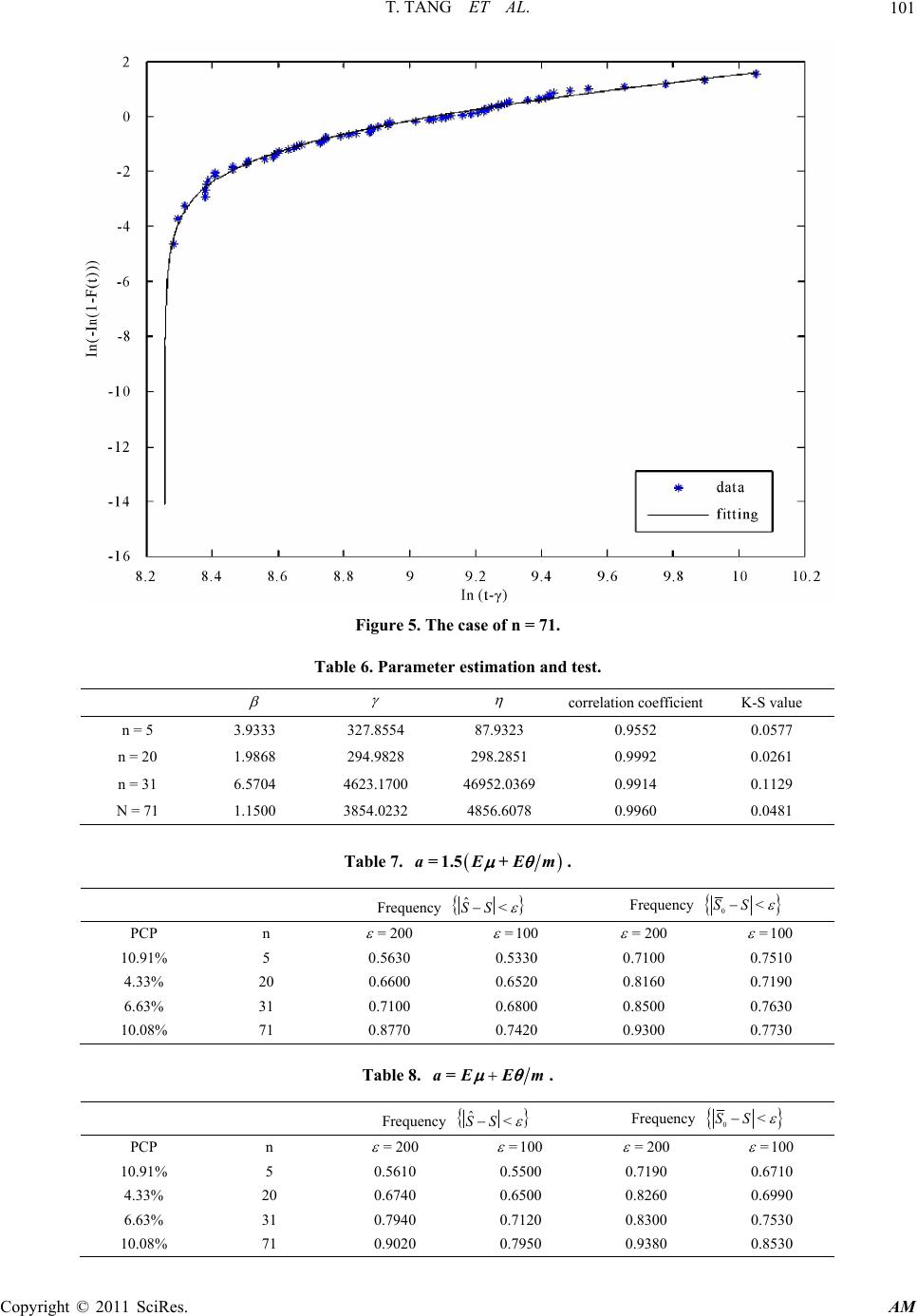 T. TANG ET AL. Copyright © 2011 SciRes. AM 101 Figure 5. The case of n = 71. Table 6. Parameter estimation and test. correlation coefficient K-S value n = 5 3.9333 327.8554 87.9323 0.9552 0.0577 n = 20 1.9868 294.9828 298.2851 0.9992 0.0261 n = 31 6.5704 4623.17 00 46952.0369 0.9914 0.1129 N = 71 1.1500 3854.0232 4856.6078 0.9960 0.0481 Table 7. =1.5 + aEEm. Frequency ˆ<SS Frequency 0<SS PCP n = 200 =100 =200 =100 10.91% 5 0.5630 0.5330 0.7100 0.7510 4.33% 20 0.6600 0.6520 0.8160 0.7190 6.63% 31 0.7100 0.6800 0.8500 0.7630 10.08% 71 0.8770 0.7420 0.9300 0.7730 Table 8. = aE Em. Frequency ˆ<SS Frequency 0<SS PCP n = 200 =100 =200 =100 10.91% 5 0.5610 0.5500 0.7190 0.6710 4.33% 20 0.6740 0.6500 0.8260 0.6990 6.63% 31 0.7940 0.7120 0.8300 0.7530 10.08% 71 0.9020 0.7950 0.9380 0.8530 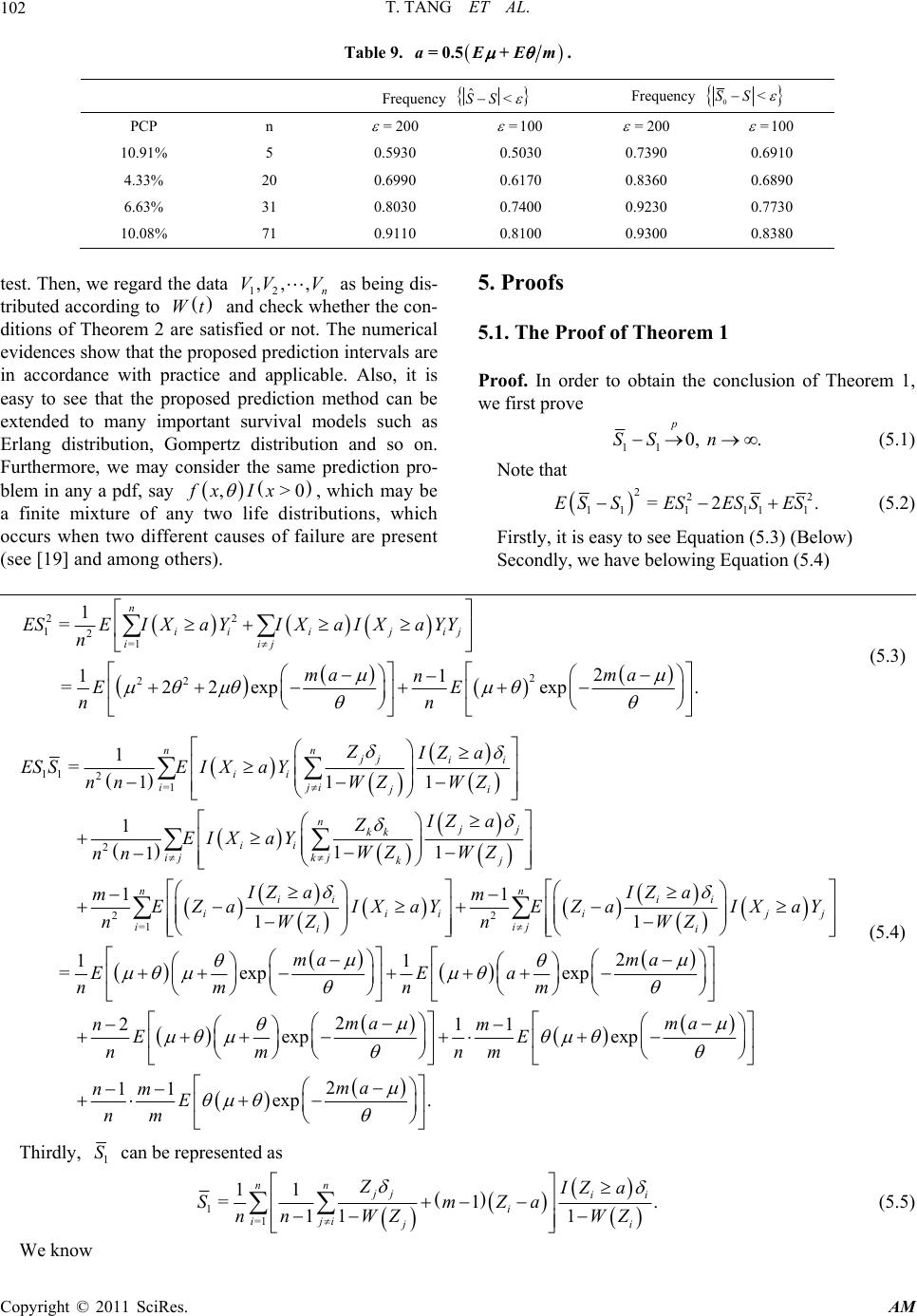 T. TANG ET AL. Copyright © 2011 SciRes. AM 102 Table 9. =0.5+ aEEm. Frequency ˆ<SS Frequency 0<SS PCP n = 200 =100 =200 =100 10.91% 5 0.5930 0.5030 0.7390 0.6910 4.33% 20 0.6990 0.6170 0.8360 0.6890 6.63% 31 0.8030 0.7400 0.9230 0.7730 10.08% 71 0.9110 0.8100 0.9300 0.8380 test. Then, we regard th e data 12 ,,, n VV V as being dis- tributed according to Wt and check whether the con- ditions of Theorem 2 are satisfied or not. The numerical evidences show that the proposed prediction in tervals are in accordance with practice and applicable. Also, it is easy to see that the proposed prediction method can be extended to many important survival models such as Erlang distribution, Gompertz distribution and so on. Furthermore, we may consider the same prediction pro- blem in any a pdf, say ,>0fx Ix , which may be a finite mixture of any two life distributions, which occurs when two different causes of failure are present (see [19] and among others). 5. Proofs 5.1. The Proof of Theorem 1 Proof. In order to obtain the conclusion of Theorem 1, we first pr ove 11 0, . p SS n (5.1) Note that 222 11111 1 =2 .ES SESESSES (5.2) Firstly, it is easy to see Equation (5.3) (Below) Secondly, we have belowing Equation (5.4) 22 12=1 2 22 1 = 2 11 =22expexp. n ii i jij iij ESEI XaYI XaI XaYY n ma ma n EE nn (5.3) 11 2=1 2 2=1 1 =11 1 1 11 1 1 1 nn jj ii ii iji ji njj kk ii ijkj kj nii iii ii ZIZ a ES SEIXaYWZ WZ nn IZa Z EIX aYWZ WZ nn IZ a mEZa IXaY WZ n 2 1 1 2 11 =expexp 2 211 exp nii ijj ij i IZ a mEZa IXaY WZ n ma ma EEa nm nm ma nm EE nm nm exp 2 11 exp. ma ma nm E nm (5.4) Thirdly, 1 S ca n be rep rese nted as 1=1 11 =1. 11 1 nn jj ii i iji ji ZIZ a SmZa n nWZWZ (5.5) We know  T. TANG ET AL. Copyright © 2011 SciRes. AM 103 2 12=1 1 1 =, n iij iijn ESQ Q n (5.6) where 22 2 2 2 2 1 =1 11 1 12 =,,, 1111 1 1, 1 njj ii ii ji ji ZIZ a QEm Za nWZ WZ XIXanIXa EEEE E nWX WXnmWX XaIXa mEE WX 21, , 1 XaIXa mE E mWX (5.7) and 2 11 =11111111 1 1 11 nn n j jjjj ii ii kk llkk ij kil jki kiljkij nj ll lj l IZaZ aIZa IZ aIZ a ZZ Z m QE E WZ WZWZWZnWZ WZWZ n IZ a Z mE nWZ 2 2 2 22 1 111 1 22 223 =,expexp 1 11 2 jjjj iii iii jii j ZaIZa ZaIZaZaIZa mE WZ WZWZWZ ma ma nX nn EE E WX m nn n 2 2 2 21 ,exp , 11 11 21 ,exp 11 2 221 exp 1 ma XI XaXI Xa EE EE WX mWX nn ma mXXaIXa EE nWX m nm E nm m 22 2 2 1exp. ama mE m (5.8) Along with Equa tions (5.3)-(5.4 ) and (5.6)-(5.8), we have 2 22 11 2 2 2 13 =2exp exp 1 2 21 exp, , 11 1 2 1 ma ma n ES SEE nnnm ma XIXa EaEE E nm nnWXWX nIX EE nn m 22 2 1 ,, 11 2 21 2 ,,exp 111 22 , 11 amXaIXa EE WX nWX ma mXaIXanX EE EE nm WXnnWX nXIXa EE nnW Xm 2 exp 21 1 ,exp, . 111 ma ma mXX aIXaXIXa EE EE nWX nnWX (5.9) Combining Equation (5.9) and using the following facts: 1) 2 2 ,>,>;EXm  T. TANG ET AL. Copyright © 2011 SciRes. AM 104 2) 222 2; 11 1 XaXIXa EE WX WaWX 3) 2 2 22 <<; 11 XIXaX a IXa EE WX WX (5.10) and also by Cauchy-Schwarz inequality, we easily know that under the conditions 1), 2) and 3), 2 11 =0. lim nES S (5.11) Then by Markov's inequality, we conclude that (5.1) holds. On the other h a nd , not e that as n 22 =1 1 =0, 1 withprobability1, niii ii IZ a SS IXa nWZ (5.12) and 2with probability1.SPXa (5.13) From Equations (5.1), (5.12) and (5.13), Theorem 1 follows. 5.2. The Proof of Theorem 2 Proof. To prove Theorem 2, it is enough to show that ˆ0. p SS (5.14) Firstly, represent 1 ˆ S as 1=1 =1 2 =1 =1 11 ˆ=ˆˆ 111 11 1ˆ 1 1 1. ˆ 1 nn jj ii ij ninj nii i ini nii i ini Z IZ a n Snn n WZ WZ ZI Za nn WZ IZ a mZa nWZ (5.15) Note that =1 =1 =1 () 11 ˆ1 1 111 sup ˆ1 1 ˆ, sup ˆ 11 with probability1, nn ii ii ii i ni n ii ZZ i i in ni ni i ZZ inni i IZ aIZ a nnWZ WZ IZ a WZ n WZ WZ WZ PX aWZWZ (5.16) since 11 =1 11, n ii i IZaEIXaWXPX a n (5.17) with probability 1. By Equation (5.16) and the following result (see [20]), () ˆ0, sup p ni i ZZ in WZ WZ (5.18) we know =1 =1 11 0. ˆ1 1 nn p ii ii ii i ni IZ aIZ a nnWZ WZ (5.19) Similarly, we have =1 =1 110, ˆ1 1 nn p jj jj jj j nj ZZ nnWZ WZ (5.20) 22 =1 =1 11 0, ˆ1 1 nn p ii iii i ii i ni ZI ZaZI Za nn WZ WZ (5.21) =1 =1 11 0. ˆ1 1 nn p ii ii ii ii i ni IZ aIZ a Za Za nnWZ WZ (5.22) Combining Equations (5.15) with (5.19)-(5.22), we conclude that 11 ˆ0, p SS (5.23) and 22 ˆ0. p SS (5.24) Hence, Equation (5.14) has been proved. Together with Theorem 1’s conclusion Theorem 2 holds. 6. Acknowledgements The authors would like to thank an anonymous referee for his helpful comments. 7. References [1] H. Robbins, “Some Thoughts on Empirical Bayes Esti- mation,” Annals of Statistics, Vol. 11, No. 3, 1983, pp. 713-723. doi:10.1214/aos/1176346239 [2] S. Zacks, “Introduction to Reliability Analysis,” Springer, New York, 1991. [3] J. Aitchison and I. R. Dunsmore, “Statistical Prediction Analysis,” Cambridge University Press, Cambridge, 1975. doi:10.1017/CBO9780511569647 [4] S. Geisser, “Predictive Inference: An Introduction,”  T. TANG ET AL. Copyright © 2011 SciRes. AM 105 Chapman and Hall, London, 1993. [5] L. J. Bain and M. Engelhardt, “Interval Estimation for the Two-Parameter Double Exponential Distribution,” Tech- nometrics, Vol. 15, No. 4, 1973, pp. 875-887. doi: 10.2307/1267397 [6] R. G. Easterling, “Exponential Responses with Double Exponetial Distribution Measurement Error-A Model for Steam Generator Inspection,” Proceedings of the DOE Statistical Symposium, U.S. Department of Energy, 1978, pp. 90-110. [7] M. T. Madi and T. Leonard, “Bayesian Estimation for Shifted Exponential Distribution,” Journal of Statistical Planning and Inference, Vol. 55, No. 6, 1996, pp. 345-351. doi:10.1016/S0378-3758(95)00199-9 [8] W. T. Huang and H. H. Huang, “Empirical Bayes Esti- mation of the Guarantee Lifetime in a Two-Parameter Exponential Distribution,” Statistics and Probability Let- ters, Vol. 76, No. 16, 2006, pp. 1821-1829. doi:10.1016/ j.spl.2006.04.034 [9] J. W. Wu, H. M. Lee and C. L. Lei, “Computational Testing Algorithmic Procedure of Assessment for Life- time Performance Index of Products with Two-Parameter Exponential Distribution,” Applied Mathematics and Computation, Vol. 190, No. 5, 2007, pp. 116-125. doi: 10.1016/j.amc.2007.01.010 [10] J. O. Berger, “Statistical Decision Theory and Bayesian Analysis,” Springer, New York, 1985. [11] R. S. Singh, “Bayes and Empirical Bayes Procedures for Selecting Good Populations from a Translated Exponen- tial Family,” Empirical Bayes and Likelihood Inference, Springer, New York, 2001. [12] H. Lian, “Consistency of Bayesian Estimation of a Step Function,” Statistics and Probability Letters, Vol. 77, No. 1, 2007, pp. 19-24. doi:10.1016/j.spl.2006.05.007 [13] Q. H. Wang, “Empirical Likelihood for a Class of Func- tions of Survival Distribution with Censored Data,” An- nals of the Institute of Statistical Mathematics, Vol. 53, No. 3, 2001, pp. 517-527. doi:10.1023/A:1014617112870 [14] E. T. Kaplan and P. Meier, “Nonparametric Estimation from Incomplete Observations,” Journal of the American Statistical Association, Vol. 53, No. 282, 1958, pp. 457- 481. doi:10.2307/2281868 [15] R. Y. Zheng, “Improvement on Grey Modelling Ap- proach and Its Applications to Fatigue Reliability Re- search,” Master Dissertation, National University of De- fense Technology, Chang Sha, 1989. [16] K. O. Bowman and L. R. Shenton, “Weibull Distributions When the Shape Parameter is Defined,” Computational Statistics and Data Analysis, Vol. 36, No. 4, 2001, pp. 299-310. doi:10.1016/S0167-9473(00)00048-7 [17] U. Singh, P. K. Gupta and S. K. Upadhyay, “Estimation of Parameters for Exponentiated-Weibull Family Under Type-II Censoring Scheme,” Computational Statistics and Data Analysis, Vol. 48, No. 3, 2005, pp. 509-523. doi:10.1016/j.csda.2004.02.009 [18] L. F. Zhang, M. Xie and L. C. Tang, “A Study of Two Estimation Approaches for Parameters of Weibull Dis- tribution Based on WPP,” Reliability Engineering and System Safety, Vol. 92, No. 3, 2007, pp. 360-368. doi: 10.1016/j.ress.2006.04.008 [19] Z. F. Jaheen, “Bayesian Prediction Under a Mixture of Two-Component Gompertz Lifetime Model,” Test, Vol. 12, No. 1, 2003, pp. 413-426. doi:10.1007/BF02595722 [20] M. Zhou, “Asymptotic Normality of the Synthetic Data Regression Estimation for Censored Survival Data,” An- nals of Statistics, Vol. 20, No. 2, 1992, pp. 1002-1021. doi:10.1214/aos/1176348667. |

